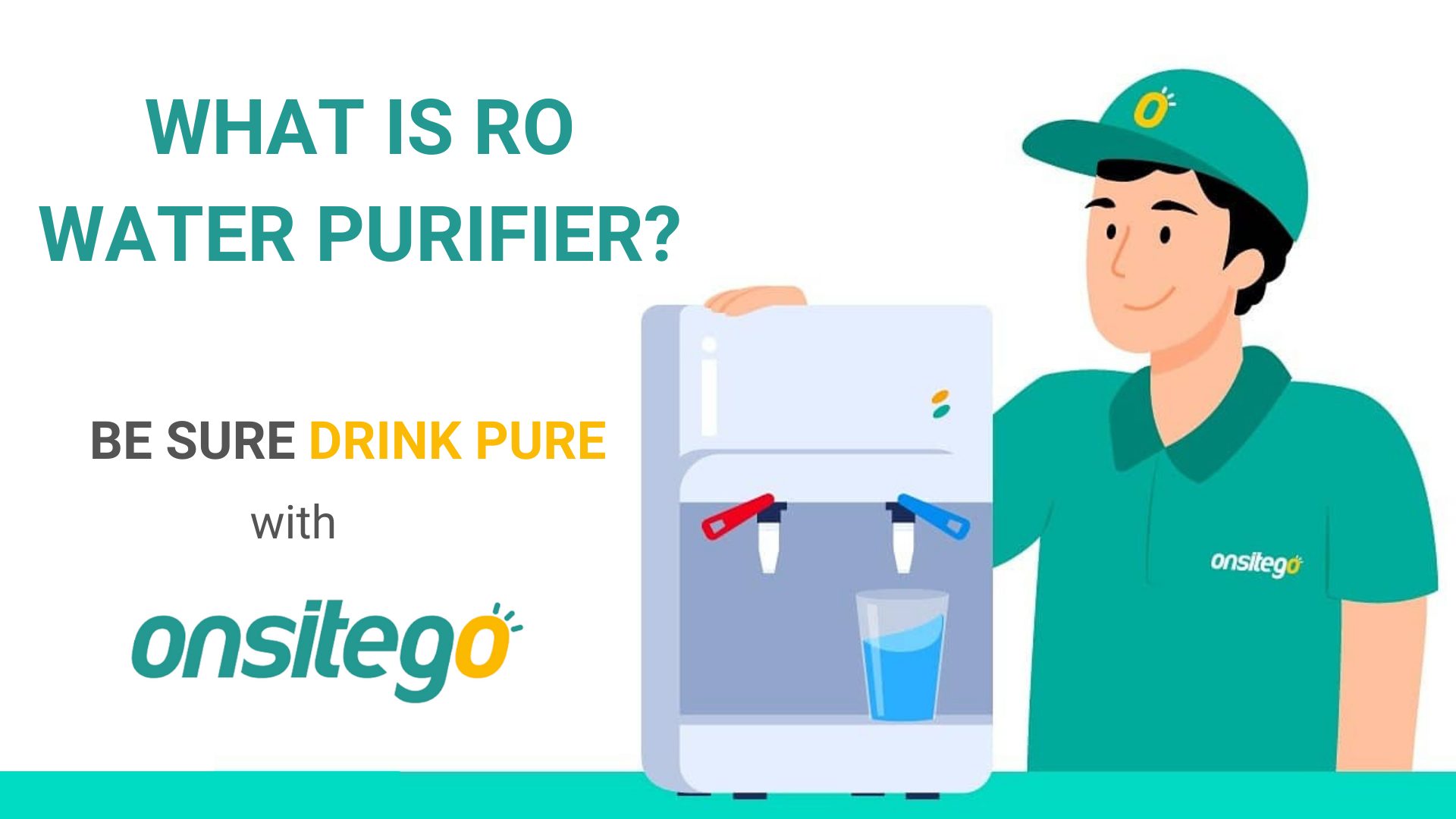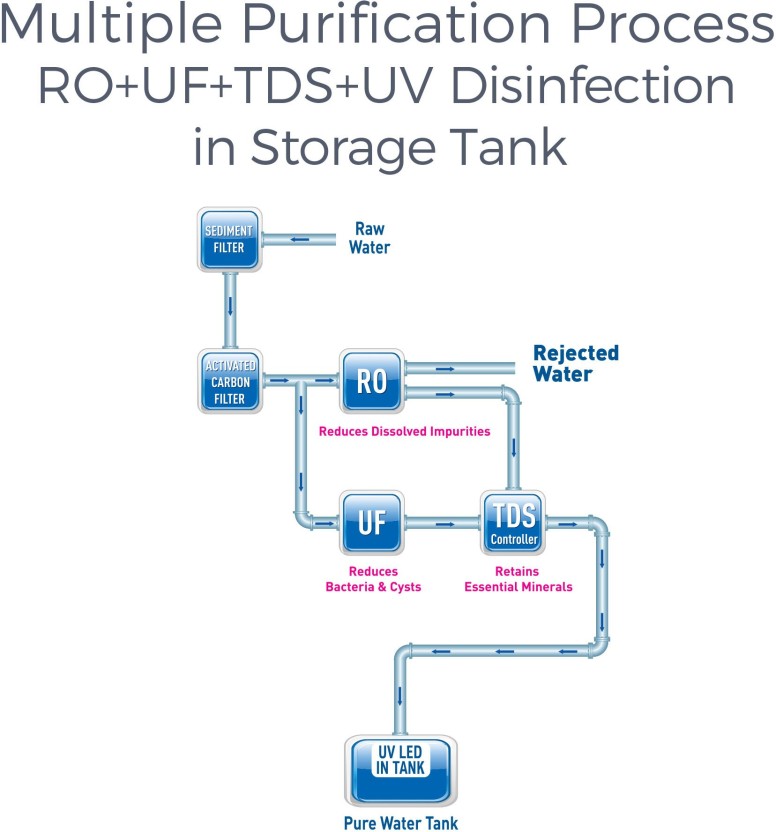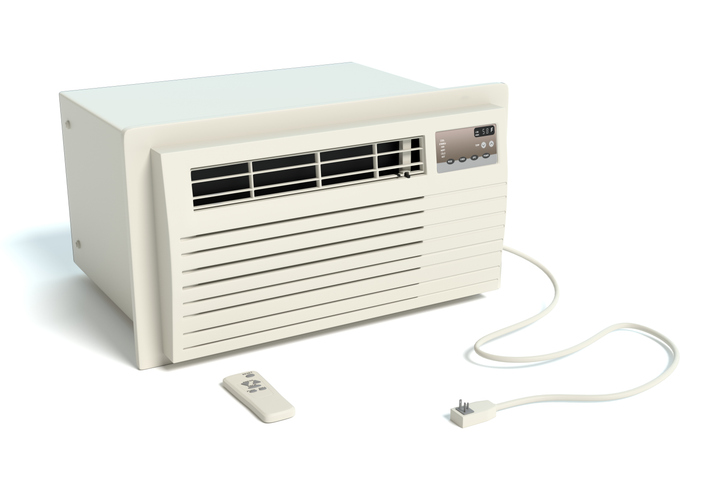
Clean drinking water prevents waterborne diseases and boosting immunity in various ways, which is why regular access to clean drinking water is considered essential.
When clean drinking water is not readily available, a water purifier becomes a necessity.
Various types of water purifiers are available in the market, and every type has its set of advantages and disadvantages.
Subscribe to Onsitego
Get the latest technology news, reviews, and opinions on tech products right into your inboxHowever, it is widely accepted that RO water purifiers are the most effective in removing impurities from water.
In this article, we will explain what is an RO water purifier, how it works and what is its pricing.
We will also list an RO water purifier’s maintenance cost, advantages and disadvantages.
What Is an RO Water Purifier & How Does RO Work?
An RO (Reverse Osmosis) water purifier uses high pressure to pass water through a semipermeable membrane (also known as RO membrane) with extremely small pores (approximately 0.0001 microns in size).
The RO membrane’s pores are so small that only water can pass through them, leaving behind impurities like bacteria, fungi, germs, salt and some heavy metals among other things.
In the end, you get clean and pure drinking water, while all the impurities are removed through a separate outlet (also known as reject line).
Apart from the RO chamber, most modern RO water purifiers come with additional forms of filtration methods, including UV (ultraviolet) and UF (ultra-filtration or gravity-based filtration).
Then there are additional filters such as the sediment filter, carbon pre-filter and carbon post-filter.
Below is a simple diagram that shows the important parts of a modern RO water purifier and how the water flows between those components before offering you clean drinking water.

An RO water purifier consists of the following stages:
-
Sediment Filter:
The sediment filter is usually the first block through which the water is passed. It removes larger-sized, visible impurities such as dirt, sand, dust, and debris. -
Carbon Pre-Filter:
The carbon pre-filter uses granular or block-activated carbon, which has a very high surface area and can remove organic impurities and chlorine (usually used by the government’s water supply board to remove bacteria and germs) through adsorption. It is usually placed before the RO membrane. -
Carbon Post-Filter:
The carbon post-filter, which is placed after the RO membrane, removes bad odour from water. -
UF Filter:
The UF chamber further purifies water. It also uses a semipermeable membrane, similar to the RO membrane, but it is not as dense. Hence, it allows minerals and salts to pass through with the water but removes bacteria, particles, and silt. -
UV Filter:
The UV chamber uses an ultraviolet lamp to neutralizes bacteria and germs in the water. If any organic matter (bacteria, fungi, or germs) pass through the previous filtering stages, they get killed by the UV rays emitted by the UV light.
As explained above most RO water purifiers also use additional filters and methods to make water as clean and pure as possible.
Compared to UV-only and UF-only water purifiers, RO-based water purifiers offer the cleanest water.
However, they also cost substantially higher and have a higher maintenance cost.
What Are the Advantages of an RO Water Purifier?
As explained earlier, RO water purifiers offer the cleanest water when compared to UV or UF water purifiers.
They remove almost all forms of bacteria, contaminants, and heavy metals. And all of this is on top of removing excess salt from the water and reducing the drinking water’s TDS.
RO water purifiers are extremely reliable and trustworthy.

What Are the Disadvantages of an RO Water Purifier?
Although they remain the most advanced form of water purifiers, RO water purifiers also have some disadvantages.
First and foremost, they cost a lot more than UV water purifiers and UF water purifiers.
Moreover, the rate of water filtration is slower compared to other types of water purifiers due to various processes taking place inside an RO water purifier.
Another disadvantage of RO water purifiers is that they need electricity to work. Hence, they are only suitable for homes that have a constant electricity supply, which may not be ideal for homes with an infrequent power supply.
Yes, they usually have water storage tanks that can store anywhere between 5 litres to 15 litres of water (depending on the model), they need at least a few hours of electricity every day to function properly.
Best RO Water Purifier Brands In India
Although there are dozens of brands that make and sell RO water purifiers in India, based on various factors, including quality, availability, pricing, after-sales service quality and coverage, we recommend buying water purifiers made by the following brands
- AO Smith
- Aquaguard (by Eureka Forbes)
- Blue Star
- Carrier
- Faber
- Havells
- Kent
- LG
- Livpure
- Mi (by Xiaomi)
- Nasaka
- Pureit (by Hindustan Unilever)
- V-Guard
- Whirlpool
You can view our list of the best RO water purifiers in India.
HOW MUCH DO RO WATER PURIFIERS COST IN INDIA?
The price of an RO water purifier starts from as low as ₹7,000 and goes as high as ₹45,000.
Obviously, this price range is for RO water purifiers that are primarily targeted towards home use.
RO water purifiers that are targeted towards offices and whole buildings can cost lakhs of rupees.
The price of an RO water purifier depends on various factors, but primarily on the water filtration rate.
Other factors include build quality, number of additional filter chambers, brand value, warranty period, service speed and quality, service coverage, the availability of hot or cold water and smart features like Wi-Fi connectivity and smartphone app.
You can read our in-depth water purifier buying guide to know more about which purifier suits you the best and what features to look out for.

WHAT IS AN RO WATER PURIFIER’S MAINTENANCE COST?
An RO water purifier’s maintenance cost can be anywhere between ₹2,000 to ₹6,000 per year, which includes the cost of replacement of the RO membrane, other pre-filters and post-filters, UV lamp and the labour cost.
An RO water purifier’s maintenance is mostly related to the replacement of the sediment filter, carbon filter, RO membrane, UV lamp (if present) and labour charge.
The sediment filter and the carbon filter usually cost around ₹500 each, and they need to be replaced every six months.
The RO membrane should be replaced every one or two years (depending on the brand and daily water usage) and it costs anywhere between ₹2,000 to ₹3,000.
You can read our detailed maintenance guide to know more about maintaining RO and UV water purifiers.
Before buying an RO water purifier, you should inquire about its annual maintenance cost and schedule along with the cost of common parts.
That would give you a clearer idea about what to expect when it comes to the cost of your RO water purifier’s maintenance cost.
You can read about RO water purifier maintenance in our detailed article.
Cities We Cover: Bangalore, Delhi NCR, Mumbai, Hyderabad, Chennai, Pune






